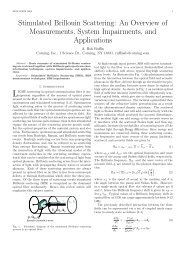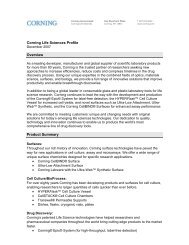You also want an ePaper? Increase the reach of your titles
YUMPU automatically turns print PDFs into web optimized ePapers that Google loves.
13. Commitments, Contingencies, and Guarantees (continued)<br />
<strong>Corning</strong> is a defendant in various lawsuits, including environmental, product-related suits, the Dow <strong>Corning</strong> and PCC matters<br />
discussed in Note 7 (Investments), and is subject to various claims which arise in the normal course of business. In the opinion of<br />
management, the ultimate disposition of these matters will not have a material adverse effect on <strong>Corning</strong>’s consolidated financial<br />
position, liquidity, or results of operations.<br />
We have been named by the Environmental Protection Agency under the Superfund Act, or by state governments under similar state<br />
laws, as a potentially responsible party for 20 active hazardous waste sites. Under the Superfund Act, all parties who may have<br />
contributed any waste to a hazardous waste site, identified by such Agency, are jointly and severally liable for the cost of cleanup<br />
unless the Agency agrees otherwise. It is our policy to accrue for the estimated liability related to Superfund sites and other<br />
environmental liabilities related to property owned and operated by us based on expert analysis and continual monitoring by both<br />
internal and external consultants. At December 31, <strong>2007</strong> and 2006, we had accrued approximately $19 million (undiscounted) and $16<br />
million (undiscounted), respectively, for the estimated liability for environmental cleanup and related litigation. Based upon the<br />
information developed to date, we believe that the accrued amount is a reasonable estimate of our liability and that the risk of an<br />
additional loss in an amount materially higher than that accrued is remote.<br />
The ability of certain subsidiaries and affiliated companies to transfer funds is limited by provisions of foreign government<br />
regulations, affiliate agreements and certain loan agreements. At December 31, <strong>2007</strong>, the amount of equity subject to such restrictions<br />
for consolidated subsidiaries totaled $1 billion. While this amount is legally restricted, it does not result in operational difficulties<br />
since we have generally permitted subsidiaries to retain a majority of equity to support their growth programs.<br />
14. Hedging Activities<br />
We operate and conduct business in many foreign countries and as a result are exposed to movements in foreign currency exchange<br />
rates. Our exposure to exchange rate effects includes:<br />
• exchange rate movements on financial instruments and transactions denominated in foreign currencies that impact earnings, and<br />
• exchange rate movements upon translation of net assets in foreign subsidiaries for which the functional currency is not the U.S.<br />
dollar that impact our net equity.<br />
Our most significant foreign currency exposures relate to Japan, Korea, Taiwan, and western European countries. We selectively enter<br />
into foreign exchange forward and option contracts with durations generally 18 months or less to hedge our exposure to exchange rate<br />
risk on foreign source income and purchases. The hedges are scheduled to mature coincident with the timing of the underlying foreign<br />
currency commitments and transactions. The objective of these contracts is to neutralize the impact of exchange rate movements on<br />
our operating results.<br />
We engage in foreign currency hedging activities to reduce the risk that changes in exchange rates will adversely affect the eventual<br />
net cash flows resulting from the sale of products to foreign customers and purchases from foreign suppliers. The hedge contracts<br />
reduce the exposure to fluctuations in exchange rate movements because the gains and losses associated with foreign currency<br />
balances and transactions are generally offset with gains and losses of the hedge contracts. Because the impact of movements in<br />
foreign exchange rates on the value of hedge contracts offsets the related impact on the underlying items being hedged, these financial<br />
instruments help alleviate the risk that might otherwise result from currency exchange rate fluctuations.<br />
The following table summarizes the notional amounts and respective fair values of <strong>Corning</strong>’s derivative financial instruments, which<br />
mature at varying dates, at December 31 (in millions):<br />
<strong>2007</strong> 2006<br />
Notional<br />
Amount<br />
Fair<br />
Value<br />
Notional<br />
Amount<br />
Foreign exchange forward contracts $ 1,421 $ (8) $ 945 $ 30<br />
Foreign exchange option contracts $ 450 $ 9<br />
Fair<br />
Value<br />
The forward and option contracts we use in managing our foreign currency exposures contain an element of risk in that the<br />
counterparties may be unable to meet the terms of the agreements. However, we minimize this risk by limiting the counterparties to a<br />
diverse group of highly-rated major domestic and international financial institutions with which we have other financial relationships.<br />
We are exposed to potential losses in the event of non-performance by these counterparties; however, we do not expect to record any<br />
losses as a result of counterparty default. We do not require and are not required to place collateral for these financial instruments.<br />
77







